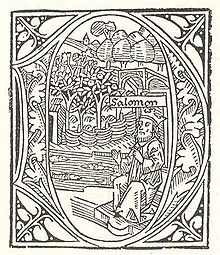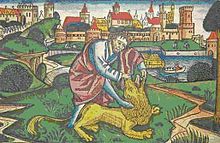Pre-Lutheran German Bibles

Pre-Lutheran German Bibles are the eighteen German Bible prints that appeared in Germany before the Luther Bible was published. The time of its publication covers the period from 1466 to 1522. Johannes Gutenberg had used the Latin translation ( Vulgate ) that was widely used at the time for his Gutenberg Bible . However, the interest of the simple clergy and the bourgeoisie increased in being able to understand the biblical stories . With the Mentelin Bible in Strasbourg in 1466, this idea of printing a Bible in a vernacular was first realized.
The Upper German issues
The text basis for the Upper German editions is unknown. It may be based on a text that is 100 years older. It is a word-for-word translation of a Latin original that does not take into account the different linguistic conditions. Here the fear of unintentional deviations from the basic text probably created barriers that Luther was to break through. The result was a text that was difficult to understand, which was used from edition to edition without any significant changes and which ultimately became the basis for a Low German translation.
The Low German editions
Although the censorship in Cologne was very strict, a consortium consisting of Heinrich Quentell , Bartholomäus von Unckel and Anton Koberger came together to create a German Bible for the Low German area. The client and the actual printer, however, remained anonymous. The Cologne Bible had to serve two regions with clearly different dialects. The only way to solve the problem was to create a Lower Rhine and Lower Saxony edition so as not to endanger the sale of the Bibles. Therefore one speaks of the Cologne Bibles (1478/79). They stood out for their book decorations and became the basis of many other Bibles. Koberger, for example, used the printing blocks directly for his Upper German 9th German Bible. The Lübeck and Halberstadt Bibles were only available in Lower Saxony.
Comparison to the Luther Bible
A comparison of the first verses of the Otmar Bible 1507 with the Luther Bible 1534:
- Otmar 1507
At that time judas went from his brothers and keret to aim man odolamites with the name hyram and saw da ain daughter ains people chananei with name sue and do he sy hett taken to ainem woman. he went to ir sy received and gave birth to ainen sune. and he was called his name. Anderwayd received a fruit. do the sune was born. he called him onan. And sy gave birth to the third, whom he calls sela. Do the what was born sy ceases to give for support But iudas gave him his firstborn sun ain weyb with the name thamar. Un her the firstborn jew was ain schalck in the face of the gentleman. That is why he was slain by im.
- Luther 1534
It came to pass around the same time / that Judah went down from his brethren / and joined a man Odollam / who was called Hira / And Judah saw there a Cananite man's daughter who was called Sua / and named her. And when he slept on her, she became pregnant and gave birth to a son, whose name was Jer. But she became pregnant / and gave birth to a son / her name was Onan. She went away and gave birth to someone she was called Sela. And he was at Chesib when she gave birth. And Judah gave his first son, Jer, a wife, whose name was Tamar. / But he was angry with the Lord / because of that he kills in the Lord
Overview of the German Bibles before Luther
| designation | year | Place of printing | Printer / Illustrator | count |
|---|---|---|---|---|
| Mentelin Bible | 1466 | Strasbourg | Johannes Mentelin | 1. |
| Eggestein Bible | before 1470 | Strasbourg | Heinrich Eggestein | 2. |
| Zainer Bible | 1475 | augsburg | Günther Zainer | 3rd / 4th |
| Planter Bible | 1475 | augsburg | Jodocus Planter | 4th / 3rd |
| Sensenschmidt Bible | 1476-78 | Nuremberg | Andreas Frisner, Johann Sensenschmidt | 5. |
| Zainer Bible | 1477 | augsburg | Günther Zainer | 6th |
| Sorg bible | 1477 | augsburg | Anton Sorg | 7th |
| Cologne Bibles | 1478/79 | Cologne | Heinrich Quentell or Bartholomäus von Unckell | 1.) Lower Saxony (East Westphalia) (and = unde) 2.) Lower Rhine (and = end) |
| Sorg bible | 1480 | augsburg | Anton Sorg | 8th. |
| Koberger Bible | 1483 | Nuremberg | Anton Koberger | 9. |
| Grüninger Bible | 1485 | Strasbourg | Johann Grüninger | 10. |
| Schönsperger Bible | 1487 | augsburg | Johann Schönsperger d. Ä. | 11. |
| Schönsperger Bible | 1490 | augsburg | Johann Schönsperger d. Ä. | 12. |
| Lübeck Bible | 1494 | Lübeck | Steffen Arndes / Master of the Lübeck Bible | Lower Saxon |
| Otmar Bible | 1507 | augsburg | Johann Otmar | 13. |
| Otmar Bible | 1518 | augsburg | Silvan Otmar | 14th |
| Halberstadt Bible | 1522 | Halberstadt | Lorenz Stuchs | Lower Saxon |
initials
Mentelin and Eggestein furnished their Bibles with Lombards - bulbous capital letters in the Romanesque style. With these initials they marked the beginning of chapters and sections. In their simplicity, they were typical of the early cradle prints . The space for the initial was initially left blank and then painted in, and later also printed in.
At Sorg and Schönsperger, the simple initials are given a may flower decoration for the first time. The Lübeck Bible has playful decorations on the initial (the U with a fool's head is known). Otmar printed floral decorations on a black background that reveal the influence of the Italian Renaissance.
At Zainer and Sensenschmidt, the initials take on a new meaning that goes beyond jewelry. The letters become a framework for the biblical story, which is captured graphically.
Illustrations
The first two Bibles were pure text editions. Zainer realized that illustrating Bibles would increase sales. In addition to the book decorations, he now also used illustrations. The following Bibles are based on this insight. The Cologne Bible contained 123 woodcuts in large format. Apparently these woodcuts were based on miniatures that appear in a group of manuscripts for which a representative (Ms. germ. Fol. 516) is archived in the Berlin State Library.
The woodcuts from the Cologne Bible were adopted by Koberger in his Bible. He had part of his print run colored in stock from the start. It was only through Koberger's edition that the styles received “their global recognition” (H. Kunze).
The Bibles according to Koberger pointed in different directions. While Grüninger and Schönsperger wanted to reduce costs and therefore downsized the woodcuts, sometimes colored carelessly and printed them on cheaper paper, the printer of the Lübeck Bible went the way of carefully combining the illustrations with the text and creating the cuts in such a way that they could even be without Coloring brought the motif to effect.
The "great" subject areas of the Bibles include creation, the exodus of the Israelites from Egypt and the horsemen of the apocalyptic of Revelation of John. The Cologne Bible dedicated 34 sections to the life and deeds of Moses associated with the excerpt.
The motifs were chosen so that the people and groups could be easily recognized. Moses was repeatedly depicted with horns (a translation error crept into the pictures since the Middle Ages). God was an old but worthy man with long white hair, who was surrounded by a halo, and the people of Israel wore the Jewish hat. It was also important that the motifs were designed in such a way that medieval people could recognize themselves in the scenes (see for example Samson with the lion).
Differentiation from pre-Lutheran German Bible manuscripts
Translations of the Latin Vulgate into German existed centuries before the German Bible was printed. Translated Gospels and the translated Psalter are known from the 8th and 9th centuries . But they remain marginal phenomena alongside Latin. Despite greater seriousness in the attempt at translation from the 14th century onwards, complete translations of the Bible remained the exception even then. Even partial reproductions were only available in small numbers. The voice quality was very fluctuating. So it was left to pressure to contribute to the widespread distribution of German Bible translations. The real breakthrough came with the translation by Martin Luther.
See also
literature
- Michael Landgraf, Henning Wendland: Biblia German. Bible and Bible illustration in the early days of printing. Evangelischer Presseverlag Pfalz, 2005
- Walter Eichenberger, Henning Wendland: German Bibles before Luther. The book art of the eighteen German Bibles between 1466 and 1522. Evang. Main Bible Society in Berlin and Altenburg, Leipzig 1980
Web links
- W. Schmitz: The transmission of German texts in Cologne book printing of the 15th and 16th centuries. Hab. Font. Cologne 1990 (PDF file; 1.26 MB)
- Collection of the German-language Bible editions between 1466 and 1799
supporting documents
- ↑ Heimo Reinitzer : Plant man, Jodocus. In: Author's Lexicon . Volume VII, Col. 575-577.
- ↑ Philipp Schmidt: The illustrations of the Luther Bible. 1522–1700 Basel 1962, pp. 66ff with direct comparisons. Ms-Link: http://www.manuscripta-mediaevalia.de/db/apsisa.dll/ast Anzeige?sid= Genealogie570c2fa9-753b-42e5-8a7a-592056486af9}&cnt=20301&no=11&display=175134#
- ↑ Hans Volz : Martin Luther's German Bible: Origin and history of the Luther Bible. Wittig, Hamburg 1978, p. 32.



